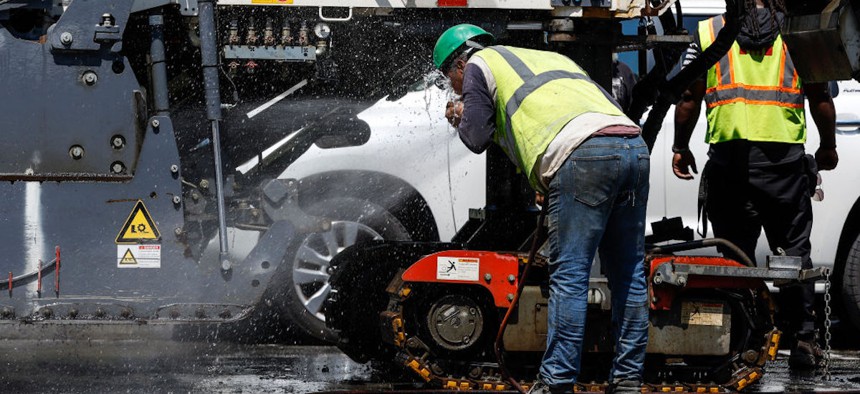Workers are dying from extreme heat. Why aren’t there laws to protect them?

A construction worker sprays water in his face during maintenance work along Pennsylvania Avenue on July 27, 2023 in Washington, DC. Anna Moneymaker/Getty Images
In the absence of federal protections, some states have attempted to pass their own regulations after experiencing worker fatalities during record-breaking heat waves.
This story is republished from Grist. Read the original article.
Jasmine Granillo was eager for her older brother, Roendy, to get home. With their dad’s long hours at his construction job, Roendy always tried to make time for his sister. He had promised to take her shopping at a local flea market when he returned from work.
“I thought my brother was coming home,” Granillo said.
Roendy Granillo was installing floors in Melissa, Texas, in July 2015. Temperatures had reached 95 degrees Fahrenheit when he began to feel sick. He asked for a break, but his employer told him to keep working. Shortly after, he collapsed. He died on the way to the hospital from heat stroke. He was 25 years old.
A few months later, the Granillo family joined protesters on the steps of Dallas City Hall for a thirst strike to demand water breaks for construction workers. Jasmine, only 11 years old at the time, spoke to a crowd about her brother’s death. She said that she was scared, but that she “didn’t really think about the fear.”
“I just knew that it was a lot bigger than me,” she said.
In December 2015, shortly after the protest, Dallas became the second city in Texas to pass an ordinance mandating water breaks for construction workers, following Austin in 2010. These protections, however, were rescinded last month when the state legislature implemented a new law blocking the local ordinances.
“I was baffled,” Granillo said. “You should be able to sit down and have a water break if you need to — if your life is on the line.”
As climate change fuels record high temperatures across the country, the number of workers who die from heat on the job has doubled since the early 1990s. Over 600 people died on the job from heat between 2005 and 2021, according to the Bureau of Labor Statistics. But federal regulators say these numbers are “vast underestimates,” because the health impacts of heat, the deadliest form of weather event, are infamously hard to track, especially in work environments. Medical examiners often misrepresent heat stroke as other illnesses, like heart failure, making them easy cases for workplace safety inspectors to miss. Some researchers estimate that the number of workplace fatalities is more likely in the thousands — every year.
Workers who already lack labor rights are often the most at risk. In many states, undocumented laborers drive outdoor industries like agriculture, landscaping, and construction. Labor advocates say it’s easier for these workers to be denied basic necessities like water, rest breaks, or even time to use the bathroom because many fear that they’ll be retaliated against and deported if they report unsafe working conditions. Between 2010 and 2021, one-third of all worker heat fatalities were Latinos.
Yet there are almost no regulations at local, state, or federal levels across the United States to protect workers.
In 2021, the Occupational Safety and Health Administration, or OSHA, announced its intent to start the process of creating protections to mandate access to water, rest, and shade for outdoor workers exposed to dangerous levels of heat. But it’s uncertain whether such a rule will ever be implemented, and most OSHA regulations take an average of seven years to be finalized. In July, Democratic representatives introduced a bill that would force OSHA to speed up this process. It was their third attempt. They have failed to secure enough votes every time.
In the absence of federal protections, some states have attempted to pass their own regulations after experiencing worker fatalities during record-breaking heat waves. But trade groups for impacted industries, like agriculture and construction, have strongly opposed these efforts, claiming that such rules are costly and unnecessary. Statewide heat regulations have been blocked in some of the hottest regions of the county. Currently, just five states — California, Oregon, Washington, Colorado, and Minnesota — have heat-related protections for workers.
“We’re asking for something so simple,” Granillo said. “Something that could save so many lives.”
Earlier this year, Paul Moradkhan, a representative from the Las Vegas Chamber of Commerce, spoke to a committee of Nevada lawmakers. They were deciding whether to implement heat protections for indoor and outdoor workers. Nevada is one of the fastest-warming states in the country, and heat-related complaints reported to workplace safety regulators more than doubled between 2016 and 2021. Moradkhan was joined by representatives from the Nevada Home Builders Association, the Nevada Resort Association, the Nevada Restaurant Association, and the Associated Builders and Contractors of Nevada, among other industry groups, all there to argue against the proposal.
“While these requirements may appear to be common sense,” Moradkhan said at the hearing, “we do believe these regulations can be complicated, egregious, burdensome, and confusing.”
The campaign was straight from a playbook that industry groups across the country have deployed to fight worker heat protections in recent years: claiming that regulations already address heat illness, businesses already protect workers, and that a one-size-fits-all approach will be costly and ineffective.
When Virginia’s Department of Labor and Industry tried to pass a heat standard in 2020, several industry groups stated that businesses should protect workers from heat in the manner best for them. The Associated General Contractors of Virginia wrote to regulators that “a one-size-fits-all approach” would harm an employer’s ability to “protect employees from heat-related illnesses.” The Prince William Chamber of Commerce, which represents the Washington, D.C. metropolitan area, wrote in a public comment that the changes being proposed were already “in practice by many, if not all businesses … operating in Virginia,” and that “requiring 15 minute break[s] each hour will hurt businesses’ bottom lines.”
The state’s Safety and Health Codes Board ultimately rejected the proposal.
In some states, industry influence has been strong enough that business leaders haven’t needed to debate the issue publicly.
Labor advocates in Florida have demanded that lawmakers pass heat protections for outdoor workers for the past five years. There have been more attempts to pass a heat protection bill in Florida than in any other state — but almost all of them have died without being heard in a single committee meeting. Industry groups have not spoken out publicly against these proposals, but lobbyists, activists, and lawmakers who support worker protections told Grist they are most likely conducting private conversations with state representatives to garner opposition.
“So much of this happens behind closed doors,” said Democratic State Representative Anna Eskamani, who has sponsored the bill each session. Business lobbyists would “rather just cut you a check and avoid the media attention,” rather than vocally oppose a pro-worker bill, she said.
In 2020, after years of advocacy from organized labor, the Maryland legislature passed a bill requiring the state’s Occupational Safety and Health Advisory Board to develop a heat standard for workers. Industry groups opposed the bill during state congressional hearings, but did not submit any public comments to regulators when they began to draft the rule.
The proposal that regulators presented after two years shocked activists. It allowed businesses themselves to decide what heat conditions were safe in their workplaces and didn’t require them to create any written heat safety plans.
“It took them two and a half years to draft this and it’s two pages long,” said Scott Schneider, the director of occupational safety and health at the nonprofit Laborers’ Health and Safety Fund of North America, who helped petition for the regulation. “We said to them, ‘This is ridiculous, if it isn’t written down, how is it enforceable?’” — referring to the fact that the regulation does not require businesses to write down their safety plans.
Advocates pushed Maryland Secretary of Labor Portia Wu to revise the rule. A representative from her office said they are currently working “to review and re-examine the standard,” but would not state whether Maryland’s rule would ultimately be amended.
After five years of inaction by the Florida legislature, WeCount! — a local labor group fighting for heat protections — spearheaded an effort to take their battle to the county level. The group pushed the Miami-Dade County Board of Supervisors to pass its own rule, hoping that the largely Latino and bipartisan district would be more sympathetic. The Miami area sees temperatures above 90 degrees for over a third of the year, a more than 60 percent increase over the last half century, putting those who work outside at considerable risk.
On September 11, the board’s Community Health Committee pushed the bill forward. It seemed possible that a heat rule could finally come to fruition in the state.
Industry groups decided to change their strategy and began to publicly oppose the measure. A long line of speakers representing the state’s agriculture and construction industries addressed the committee, calling the bill costly and convoluted. Barney Rutzke Jr., president of the Miami-Dade Farm Bureau, who spoke at the hearing, questioned the need for the regulation, claiming that there are “already OSHA rules and standards in place.” When a worker is seriously injured, OSHA can fine employers if they determine that their workplaces are unsafe, but the agency has no specific requirements that businesses must follow concerning heat. Carlos Carillo, executive director of the South Florida chapter of the Associated General Contractors of America, said that “a vote for the ordinance is a vote against Miami-Dade’s construction and agricultural businesses.”
“They are scared,” said Esteban Wood, WeCount!’s policy director, “because they think that it might pass.”
While the hottest regions of the country have blocked heat protections for workers, there are some states in the West that have gotten it right, reacting to mounting worker deaths.
During a blistering three-week heat wave in California’s Central Valley in 2005, temperatures reached 105 degrees as Constantino Cruz struggled to sort thousands of tomatoes on top of a mechanical harvester. When his shift ended, Cruz collapsed. He was one of six workers to die from heat on the job in California that summer. United Farm Workers, one of the most powerful agricultural unions in the country, pushed lawmakers to respond. Shortly after Cruz’s death, his family joined Governor Schwartzenegger to announce an emergency heat protection for outdoor workers. A year later, the first statewide heat standard was enacted.
But the deaths continued.
The year after the law passed, three more farm workers died, and in 2007, regulators found that more than half of the employers they audited were violating the new rule.
United Farm Workers, a labor union, and the American Civil Liberties Union, or ACLU, sued California’s Occupational Safety and Health Administration, or Cal-OSHA, charging that the agency had failed to protect workers from heat. In 2015, Cal-OSHA settled the lawsuit by agreeing to strengthen its regulation, mandating rest breaks every two hours when temperatures reached 95 degrees and special emergency medical plans for heat illness.
Researchers began to see results. The Washington Center for Equitable Growth, a nonprofit research organization, analyzed worker compensation data in California and found that workplace injuries from heat had declined 30 percent since the state created its regulation.
California’s heat rule became a model for other states, and its neighbor to the north also recently finalized heat protections.
In 2021, an unprecedented heat wave descended on the Pacific Northwest, killing around 800 people in Oregon, Washington, and Colorado. In Portland, Oregon, temperatures reached 116 degrees, buckling sidewalks and melting electrical cables. Millions of shellfish were decimated along the Pacific coast.
Labor rights activists had been petitioning Oregon state regulators for years to protect outdoor workers from heat. But until the 2021 disaster, “I think we all kind of thought of heat as an inconvenience more than an actual, lethal threat,” Kate Suisman, an attorney and campaign coordinator with the Northwest Workers’ Justice Project, said. That changed quickly.
Oregon OSHA passed the strongest heat protections in the country, covering both indoor and outdoor workers, in 2022. Washington and Colorado created their own standards that same year.
“It was an immediate hazard,” said Ryan Allen, a regulator for Washington’s Department of Occupational Safety and Health, who helped oversee the state’s rule-making process. “We needed to address it.”
Elizabeth Strater, an organizer with United Farm Workers in Washington, said that their effort faced “robust pushback” from industry leaders in agriculture and construction. But strong coalitions of labor groups, environmental advocates, and immigrant rights organizations were able to persuade policymakers to act. The visible impacts of climate change that summer helped build a consensus among advocates and regulators that heat was becoming a threat to everyone in the state.
The reality was setting in that “heat is coming for us all,” Strater said.
In 2022, Oregon Manufacturers and Commerce, Associated Oregon Loggers, Inc., and Oregon Forest & Industries Council sued the state’s OSHA to block its new rule, arguing that heat is a general hazard that affects employees beyond the workplace and should therefore be treated as a public health risk, not a workplace issue. But their lawsuit was dismissed.
In Texas, industry opposition has been more effective. Over a decade after labor advocates successfully pushed for mandatory water breaks for construction workers in Austin and Dallas, State Representative Dustin Burrows, a Republican, introduced the Texas Regulatory Consistency Act, which bars cities and counties from adopting stricter regulations than the state.
The new legislation is alarming, said David Chincanchan, policy director at the labor rights group Workers Defense Project. Before, policymakers were simply ignoring their demands, he said. “Now they’ve moved beyond inaction to obstruction.”
Around the same time that Burrows introduced the Texas Regulatory Consistency Act, State Representative Maria Luisa Flores, a Democrat, authored a bill that would’ve created an advisory board responsible for establishing statewide heat protections and set penalties for employers that violate the standard. Her bill never got a hearing.
The issue “just wasn’t a priority for the leadership,” she said.
Houston and San Antonio have fought back, suing the state on the grounds that the new act violates the Texas Constitution. It’s unknown whether their lawsuit will be able to overturn the law.
Jasmine Granillo worries that her father, who still works in construction, faces the same risks her brother did. She encourages him to take breaks, but sometimes his employers push him to work beyond his limits, she said. Motivated by her brother’s death, Granillo has decided to pursue medicine, and the 19-year-old continues to advocate for heat protections to honor Roendy.
“I know that doing this will always keep him alive,” she said.
This story is co-published with The Guardian and produced in partnership with the Toni Stabile Center for Investigative Journalism and the Mailman School of Public Health at Columbia University. It is part of Record High, a Grist series examining extreme heat and its impact on how — and where — we live.
Victoria D. Lynch, a postdoctoral research scientist at Columbia University’s Mailman School of Public Health, contributed to this project. Heat-related data were produced and processed by Robbie M. Parks, an environmental epidemiologist and Assistant Professor at Columbia University’s Mailman School of Public Health, and Cascade Tuholske, a geographer and Assistant Professor at Montana State University.





